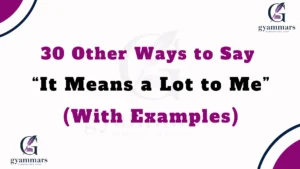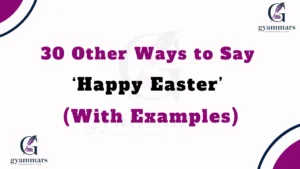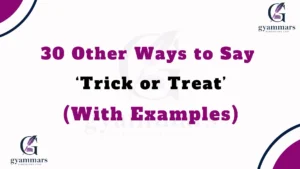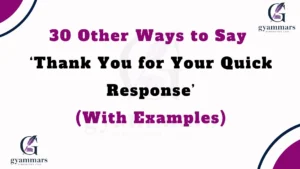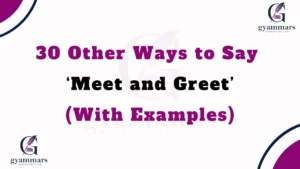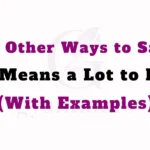Finding the right words to express empathy can make all the difference in a conversation. Whether you’re consoling a friend, addressing a customer complaint, or responding to a colleague, how you phrase your message can impact how it’s received. Using warm and thoughtful alternatives can make your response more personal, genuine, and comforting.
Below, you’ll find 30 powerful alternatives to say “I understand your frustration” in different situations. Each option includes definitions, explanations, real-life examples, the best usage, tone, and additional notes to help you choose the right phrase.
What Does “I Understand Your Frustration” Mean?
“I understand your frustration” is a phrase used to acknowledge someone’s feelings of irritation, disappointment, or distress. It expresses empathy, showing that you recognize their emotions and validate their concerns.
This phrase is often used in customer service, professional settings, and personal conversations to reassure someone that their feelings matter. However, using alternative expressions can make your response sound more personal, engaging, and supportive.
Is It Professional/Polite to Say “I Understand Your Frustration”?
Yes, “I understand your frustration” is generally polite and professional. However, it can sometimes come across as generic or robotic, especially in customer service interactions. If overused, it may not feel genuine or personalized to the situation.
Using alternative phrases can help you express more warmth, sincerity, and understanding while maintaining professionalism.
Pros and Cons of Saying “I Understand Your Frustration”
Pros
✔️ Shows empathy – It acknowledges the other person’s emotions.
✔️ Professional and neutral – Suitable for workplace and formal settings.
✔️ Commonly accepted – Recognizable and easily understood.
Cons
✖️ Can feel impersonal – May sound scripted or overused.
✖️ Lacks depth – Doesn’t always show a deep level of engagement.
✖️ May not always de-escalate situations – Some people may feel dismissed if not paired with a solutio
Synonyms For “I Understand Your Frustration”
- I hear you.
- I see where you’re coming from.
- That sounds really frustrating.
- I totally get how you feel.
- I can imagine how upsetting that must be.
- That must be really difficult for you.
- I recognize how tough this is.
- I completely understand your concerns.
- I know this is frustrating.
- I acknowledge how upsetting this is.
- I get why you’re upset.
- I see why this is bothering you.
- That’s really tough—I’d feel the same way.
- I understand where you’re coming from.
- I realize how important this is to you.
- I know how challenging this must be.
- That must be really annoying.
- I appreciate how difficult this is.
- I can see why you’d be upset.
- I completely empathize with you.
- I understand why this matters to you.
- I know how frustrating that can be.
- I recognize why you’re feeling this way.
- That’s a really difficult situation.
- I understand this isn’t easy for you.
- I get why this is a big deal for you.
- That sounds really stressful.
- I hear your concerns and frustrations.
- I acknowledge how you’re feeling.
- I know this must be upsetting for you.
1. I Hear You
Definition: A short, empathetic phrase that reassures the person that you’re listening.
Explanation: This phrase makes the other person feel heard without sounding robotic. It emphasizes active listening.
Scenario Example:
Person A: “I’ve been waiting for hours, and no one is helping me!”
Person B: “I hear you, and I want to find a solution right away.”
Best Use: Conversations where the other person mainly wants to be acknowledged.
Tone: Warm, supportive, and conversational.
Additional Notes: Works well in personal and professional settings.
2. I See Where You’re Coming From
Definition: A phrase that shows you understand their perspective.
Explanation: This phrase conveys open-mindedness and empathy while remaining neutral.
Scenario Example:
Customer: “I don’t understand why this policy exists—it’s so inconvenient!”
Agent: “I see where you’re coming from, and I’d love to explain the reasoning behind it.”
Best Use: Situations where you want to acknowledge concerns while providing an explanation.
Tone: Professional, understanding, and diplomatic.
Additional Notes: Useful in customer service and workplace discussions.
3. That Sounds Really Frustrating
Definition: A phrase that directly acknowledges the frustration someone is experiencing.
Explanation: This response validates the person’s feelings without assuming too much about their situation. It reassures them that their emotions are understood.
Scenario Example:
Person A: “I’ve called three times, and I keep getting disconnected!”
Person B: “That sounds really frustrating. Let me help you resolve this now.”
Best Use: When responding to someone who is venting or upset.
Tone: Empathetic, direct, and conversational.
Additional Notes: Works well in both professional and personal conversations.
4. I Totally Get How You Feel
Definition: A phrase that expresses full understanding of the other person’s emotions.
Explanation: This phrase adds a personal touch, making the conversation feel less formal and more engaging.
Scenario Example:
Friend: “I studied so hard for this test, and I still didn’t do well.”
You: “I totally get how you feel. I’ve been there too—it’s so disappointing.”
Best Use: Casual conversations where emotional validation is needed.
Tone: Warm, understanding, and supportive.
Additional Notes: Avoid using this if you haven’t actually experienced a similar situation, as it might come across as insincere.
5. I Can Imagine How Upsetting That Must Be
Definition: A phrase that expresses empathy by putting yourself in the other person’s shoes.
Explanation: It communicates that you recognize the difficulty of their situation and are trying to understand their emotions.
Scenario Example:
Customer: “My package was supposed to arrive last week, and it still hasn’t shown up.”
Support Agent: “I can imagine how upsetting that must be. Let’s track it and see how we can fix this.”
Best Use: When responding to someone who is distressed and needs reassurance.
Tone: Professional, warm, and reassuring.
Additional Notes: Useful in customer service or support roles.
6. That Must Be Really Difficult for You
Definition: A phrase that acknowledges the hardship someone is experiencing.
Explanation: This phrase makes the person feel validated without assuming how they feel.
Scenario Example:
Person A: “I’m dealing with so many issues at once—it’s overwhelming.”
Person B: “That must be really difficult for you. Is there anything I can do to help?”
Best Use: When offering emotional support to someone dealing with a tough situation.
Tone: Compassionate, understanding, and supportive.
Additional Notes: A good choice when you want to offer comfort without minimizing their struggle.
7. I Recognize How Tough This Is
Definition: A formal way to acknowledge someone’s challenges.
Explanation: This phrase reassures the other person that their difficulties are seen and understood.
Scenario Example:
Colleague: “This project has so many moving parts, and I’m struggling to keep up.”
You: “I recognize how tough this is. Let’s break it down together.”
Best Use: Work and business settings where professionalism is key.
Tone: Professional, empathetic, and reassuring.
Additional Notes: Works well in leadership and management roles.
8. I Completely Understand Your Concerns
Definition: A phrase used to validate someone’s worries or frustrations.
Explanation: This response ensures the other person that their concerns are heard and taken seriously.
Scenario Example:
Customer: “I’m worried about the security of my personal data on your platform.”
Support Agent: “I completely understand your concerns. Let me explain how we protect your information.”
Best Use: When addressing customer or client concerns in a professional setting.
Tone: Formal, respectful, and reassuring.
Additional Notes: Ideal for customer service, leadership, and client interactions.
9. I Know This Is Frustrating
Definition: A direct acknowledgment of someone’s irritation or disappointment.
Explanation: This phrase keeps it simple while still expressing empathy.
Scenario Example:
Employee: “I keep getting errors in the system, and it’s slowing me down.”
Manager: “I know this is frustrating. Let’s get IT to look into it right away.”
Best Use: When you want to be direct but still show empathy.
Tone: Professional, concise, and understanding.
Additional Notes: Good for quick responses in a work environment.
10. I Acknowledge How Upsetting This Is
Definition: A phrase that formally recognizes the other person’s emotions.
Explanation: It assures the person that their feelings are being taken seriously.
Scenario Example:
Client: “I feel like my concerns were ignored in the last meeting.”
You: “I acknowledge how upsetting this is. Let’s make sure we address them now.”
Best Use: When discussing emotional concerns in professional or personal settings.
Tone: Formal, empathetic, and validating.
Additional Notes: Useful when handling complaints or sensitive conversations.
11. I Get Why You’re Upset
Definition: A phrase that validates someone’s emotions by acknowledging their distress.
Explanation: This phrase expresses genuine understanding while remaining casual and conversational.
Scenario Example:
Person A: “They changed the deadline last minute! Now I have to redo everything.”
Person B: “I get why you’re upset. That’s really frustrating.”
Best Use: Personal and workplace conversations where you need to offer quick validation.
Tone: Supportive, informal, and empathetic.
Additional Notes: Works well in casual and professional settings but avoid using it in formal emails.
12. I See Why This Is Bothering You
Definition: A phrase that conveys attentiveness and understanding.
Explanation: This lets the person know their emotions are acknowledged and taken seriously.
Scenario Example:
Client: “I don’t think my concerns were addressed in the last meeting.”
You: “I see why this is bothering you. Let’s make sure we go over them now.”
Best Use: When discussing concerns in a professional setting.
Tone: Professional, empathetic, and reassuring.
Additional Notes: A great choice for customer service and conflict resolution.
13. That’s Really Tough—I’d Feel the Same Way
Definition: A response that emphasizes shared emotions.
Explanation: This phrase builds rapport by expressing relatability and empathy.
Scenario Example:
Colleague: “I’ve been working late every night, and I still have more to do.”
You: “That’s really tough—I’d feel the same way. Let’s see if we can divide the workload.”
Best Use: When offering emotional support in both personal and professional settings.
Tone: Warm, personal, and reassuring.
Additional Notes: Avoid using this unless you truly relate, or it may seem insincere.
14. I Understand Where You’re Coming From
Definition: A phrase that validates another person’s perspective.
Explanation: This phrase acknowledges the other person’s viewpoint without necessarily agreeing.
Scenario Example:
Teammate: “I think we should take a different approach to this project.”
You: “I understand where you’re coming from. Let’s weigh the pros and cons.”
Best Use: Professional discussions and negotiations.
Tone: Neutral, professional, and diplomatic.
Additional Notes: Great for diffusing conflicts and maintaining open communication.
15. I Realize How Important This Is to You
Definition: A phrase that reassures someone that their concerns are valued.
Explanation: It shows respect and recognition of the other person’s priorities.
Scenario Example:
Customer: “I really need this issue resolved today.”
Support Agent: “I realize how important this is to you. I’ll make it my top priority.”
Best Use: Customer service, leadership, and personal relationships.
Tone: Professional, understanding, and encouraging.
Additional Notes: Ideal for defusing tension when someone is upset.
16. I Know How Challenging This Must Be
Definition: A phrase that expresses empathy for someone’s struggles.
Explanation: This validates the difficulty of a situation without minimizing emotions.
Scenario Example:
Employee: “I’m juggling multiple projects, and it’s overwhelming.”
Manager: “I know how challenging this must be. Let’s discuss how we can balance your workload.”
Best Use: Workplace interactions and motivational conversations.
Tone: Encouraging, professional, and supportive.
Additional Notes: A good way to show leadership and guidance.
17. That Must Be Really Annoying
Definition: A casual way to acknowledge someone’s frustration.
Explanation: This phrase keeps things light yet empathetic.
Scenario Example:
Friend: “I’ve been waiting for this appointment forever!”
You: “That must be really annoying. Hopefully, they get to you soon.”
Best Use: Informal conversations with friends and coworkers.
Tone: Casual, sympathetic, and friendly.
Additional Notes: Not suitable for professional settings.
18. I Appreciate How Difficult This Is
Definition: A phrase that expresses gratitude for someone’s patience in a tough situation.
Explanation: This lets the person know you value their perspective.
Scenario Example:
Colleague: “This project has been really stressful for me.”
You: “I appreciate how difficult this is. Let’s work through it together.”
Best Use: Professional settings where encouragement is needed.
Tone: Formal, respectful, and supportive.
Additional Notes: Effective in leadership and teamwork situations.
19. I Can See Why You’d Be Upset
Definition: A phrase that validates the other person’s frustration.
Explanation: It reassures the person that their reaction is reasonable and understood.
Scenario Example:
Customer: “I was charged twice for my order!”
Support Agent: “I can see why you’d be upset. Let’s get this fixed immediately.”
Best Use: Customer service and conflict resolution.
Tone: Professional, calm, and understanding.
Additional Notes: Avoid saying this without offering a solution.
20. I Completely Empathize With You
Definition: A phrase that expresses deep emotional understanding.
Explanation: This phrase shows that you truly care about their experience.
Scenario Example:
Friend: “I feel like I’m being treated unfairly at work.”
You: “I completely empathize with you. That must be so frustrating.”
Best Use: Emotional support in personal and professional conversations.
Tone: Warm, heartfelt, and compassionate.
Additional Notes: Use when you want to build trust and connection.
21. I Can See Why This Is Stressful for You
Definition: A phrase that validates someone’s feelings of stress.
Explanation: This acknowledges the mental burden of the situation without being dismissive.
Scenario Example:
Colleague: “I have three deadlines this week, and I don’t know how I’ll manage.”
You: “I can see why this is stressful for you. Let’s figure out a plan together.”
Best Use: Work environments, emotional support, and professional settings.
Tone: Supportive, professional, and reassuring.
Additional Notes: A great way to offer solutions without minimizing emotions.
22. I Appreciate That This Is a Big Deal for You
Definition: A phrase that recognizes the importance of the issue to the other person.
Explanation: This shows you value their concerns and understand their priorities.
Scenario Example:
Customer: “I need this issue resolved today—it’s really urgent.”
Support Agent: “I appreciate that this is a big deal for you. I’ll do my best to help immediately.”
Best Use: Customer service, workplace communication, and personal interactions.
Tone: Respectful, serious, and understanding.
Additional Notes: Ideal for defusing tense situations when someone feels unheard.
23. I Can Relate to How You’re Feeling
Definition: A phrase that expresses personal connection to someone’s frustration.
Explanation: This phrase reassures the person that they are not alone in how they feel.
Scenario Example:
Friend: “I feel so overwhelmed with all these responsibilities.”
You: “I can relate to how you’re feeling. It’s really tough to juggle everything at once.”
Best Use: Personal relationships and supportive conversations.
Tone: Warm, personal, and empathetic.
Additional Notes: Only use if you truly relate—forced empathy can feel insincere.
24. I Understand That This Is Really Important to You
Definition: A phrase that recognizes the significance of the situation.
Explanation: It reassures the other person that their concerns matter to you.
Scenario Example:
Colleague: “I need these documents finalized today, or we’ll miss the deadline.”
You: “I understand that this is really important to you. I’ll make it my priority.”
Best Use: Workplace discussions, leadership, and personal matters.
Tone: Professional, serious, and reassuring.
Additional Notes: A good phrase for motivating and calming someone down.
25. I Completely Acknowledge How You Feel
Definition: A phrase that emphasizes recognition of emotions.
Explanation: This is a stronger validation than simply saying “I understand.”
Scenario Example:
Customer: “I’ve been waiting for an update, and no one has gotten back to me.”
You: “I completely acknowledge how you feel. That’s unacceptable, and I’ll follow up immediately.”
Best Use: Professional settings, customer service, and leadership.
Tone: Empathetic, firm, and reassuring.
Additional Notes: Use when you want to reinforce commitment to resolving an issue.
26. I Hear You, and I Want to Help
Definition: A phrase that validates frustration and offers a solution.
Explanation: This assures the other person that you genuinely care about their feelings.
Scenario Example:
Friend: “I feel like no one is listening to me about this issue.”
You: “I hear you, and I want to help. Let’s figure out the next steps together.”
Best Use: Supportive personal conversations and conflict resolution.
Tone: Warm, compassionate, and proactive.
Additional Notes: Avoid saying this if you don’t intend to take action.
27. I Know This Situation Is Frustrating for You
Definition: A phrase that directly acknowledges frustration.
Explanation: This reassures the other person that their feelings are valid and understandable.
Scenario Example:
Employee: “The system keeps crashing, and I’m losing my work!”
Manager: “I know this situation is frustrating for you. I’ll escalate this immediately.”
Best Use: Workplace frustration, customer service, and emotional support.
Tone: Empathetic, neutral, and problem-solving.
Additional Notes: A good neutral phrase that works in both personal and professional contexts.
28. I Understand Why You Feel This Way
Definition: A phrase that directly acknowledges emotions.
Explanation: It shows the person you accept their emotions without judgment.
Scenario Example:
Colleague: “I feel like my ideas aren’t being considered in this project.”
You: “I understand why you feel this way. Let’s discuss how we can address that.”
Best Use: Conflict resolution and workplace communication.
Tone: Diplomatic, respectful, and neutral.
Additional Notes: Encourages open dialogue without making the other person defensive.
29. That Sounds Like a Really Tough Situation
Definition: A phrase that expresses sympathy and understanding.
Explanation: This lets the person know their struggles are being recognized.
Scenario Example:
Friend: “I’ve been dealing with a lot at work and home.”
You: “That sounds like a really tough situation. I’m here for you.”
Best Use: Personal conversations and emotional support.
Tone: Caring, warm, and comforting.
Additional Notes: A great way to start a supportive conversation.
30. I Can Only Imagine How Hard This Must Be for You
Definition: A phrase that conveys deep empathy and care.
Explanation: This phrase expresses sincere sympathy for someone’s struggles.
Scenario Example:
Colleague: “I’ve been managing this project alone, and it’s overwhelming.”
You: “I can only imagine how hard this must be for you. Let’s see if we can lighten the load.”
Best Use: Deep emotional support and encouragement.
Tone: Gentle, warm, and deeply empathetic.
Additional Notes: Best used in serious or emotional discussions.
Conclusion
Finding the right words to express empathy and understanding can transform your communication. Instead of using the standard “I understand your frustration,” choosing a phrase that matches the tone and situation makes your message feel more genuine and thoughtful.
With these 30 alternative phrases, you can ensure that your words offer comfort, validation, and encouragement. Whether you’re helping a friend, supporting a coworker, or calming a customer, these phrases will help you communicate with warmth and sincerity.
FAQs
1. Why Should I Use Alternatives Instead of Just Saying “I Understand Your Frustration”?
Using alternatives makes your response feel more personal, warm, and empathetic. The phrase “I understand your frustration” can sometimes sound generic or robotic, especially in professional settings like customer service. Choosing a more tailored response shows that you are truly listening.
2. Are These Alternatives Suitable for Professional Settings?
Yes! Many of these phrases, such as “I completely understand your concerns” or “I appreciate that this is a big deal for you,” are perfect for workplace communication, customer service, and leadership roles. Just be mindful of your tone and the level of formality required.
3. What Is the Best Way to Show Empathy in Customer Service?
Empathy in customer service involves acknowledging the customer’s feelings while offering a solution. Phrases like “I hear you, and I want to help” or “I completely acknowledge how you feel” can make the customer feel heard and valued.
4. Can These Phrases Be Used in Personal Conversations?
Absolutely! Many of these alternatives, like “That must be really difficult for you” or “I can imagine how upsetting that must be,” are great for supporting friends, family, and loved ones. They make conversations feel more caring and sincere.
5. How Do I Choose the Right Alternative for Different Situations?
Consider the context and the relationship you have with the person:
- For formal or workplace settings → Use “I appreciate how difficult this is” or “I completely understand your concerns.”
- For customer service → Use “I hear you, and I want to help” or “I recognize how tough this is.”
- For friends and family → Use “That must be really frustrating” or “I can only imagine how hard this must be for you.”

“Mia Rose at Grammar Synonyms is your ultimate guide to mastering language with style and precision. Whether you’re looking to enhance your vocabulary, perfect your grammar, or discover the ideal synonym, Mia Rose offers expert resources and creative solutions to help you express yourself flawlessly. With Grammar Synonyms, unlock a world of language possibilities and elevate every piece of writing you create.


